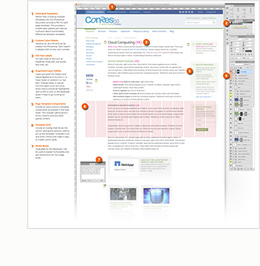Information design is the neglected stepchild of web development. This is unfortunate, though, because the truth is that a site’s information design is more important than its visual design, content, programming, measurement, calls to action, or anything else. Of course, any good site requires all of those things, but, without the right information design, those elements will not have the structure they need to be effective, and the site will be as weak and precarious as a house of cards.
DON’T LEAD WITH DESIGN
Communicating about the web is hard to do, and many of the agencies I speak with have a hard time figuring out how to build client sites without losing some combination of their reputation, bankroll, and sanity. It does not have to be this way, though. You are capable of putting together a great web project, you just need to have the right process. The main problem we all encounter when approaching a web development project is that a commonsense approach to web development does not work. A good example of this is the way most agencies begin the process of building a website: with design.
Back in Newfangled’s early days when I was just learning about sales and how to run client meetings. I noticed that almost every agency I met had the same approach: they wanted to show their clients designs as quickly as possible. Some even wanted to show design before they were hired.
Since we are often involved in the earliest stages of the projects we work on with our agency partners, we used to sit in on a lot of the meetings during which they would “reveal” their initial designs to the client. Before the reveal, both the agency and the client would be excited, but then the agency would show the home page, for example, and the mood in the room would change—usually not for the better.
Prior to that meeting, the client had usually seen very little in the way of information design, maybe a sitemap, at best.That meant that everything was riding on the homepage that was just revealed. By everything, I mean the client’s understanding of the navigation systems, the elements depicted on the homepage, the logo treatment on the web, and even the fonts, colors, imagery, and patterns throughout the site.
The agency had already had the benefit of considering all of these elements one by one and, therefore, had an understanding of how everything related and probably had a vision for how a web user would interact with the designed elements. The poor client, however, saw everything for the first time right then. When the client saw the homepage, they worried about how much of the design budget this represented, what their boss would think of it, and how their response would affect the agency (who was clearly looking for some immediate input), all while trying to process the hundreds of big and small decisions the agency made during the design creation process. The cumulative weight of all of these questions is enough to make anyone short-circuit from information overload. In those sessions, we knew the client’s mind went AWOL when they said something like, “The CEO doesn’t like blue.”
I have heard many agencies complain that their web projects fail because their clients cannot make up their minds about anything and are continually contradicting themselves. These agencies are not delusional; their clients really are giving them lousy feedback. But it is not the client’s fault, it’s the agency’s.
Clients hire you because they cannot build their website themselves. They need you to expertly guide them through the difficult and unintuitive web development process. As a guide, it is one of your responsibilities to never give your clients more information than they can process. You should always put them in situations in which they can succeed. They will only be successful if you can give accurate and timely feedback, so the onus is on you to show them only as much as they can comprehend and respond to promptly.
The client in the above scenario would not be able to ignore the currently “unimportant” elements of the page and just give feedback on the design. It does not matter how often or
emphatically you tell them to look here and not there. They are going to look everywhere. When you lead with design, clients will instinctively look at everything but the design elements. “Is that what our main navigation should be?”, “Do we really want a picture of Herb on the homepage?”, and “Where’s the mission statement we just spent the past ten months writing?” are examples of things that race through your client’s head when you overwhelm them with a design-first approach to web development.
You should lead clients in a logical and consistent way through the web development process, and there is only one place to start: information design. Information design comes first, and visual design comes second.
This post is an excerpt from my book, “A Website That Works.”
#macro:blognav,23689,23694#

